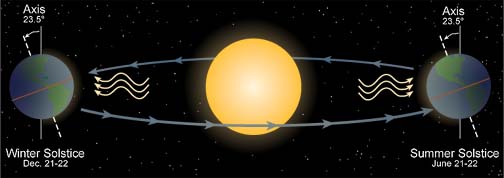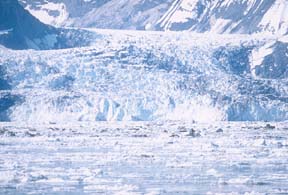First of all, at the equator, the energy from the sun or the solar energy strikes the earth very nearly perpendicularly to the earth's surface, and the second thing is that the solar energy is not spread out over such a large area of the earth's surface, as a consequence of hitting it at an angle.

 Another
interesting phenomena occurs as a consequence of the tilting of the
earth's axis both toward and away from the sun. Note, when the North Pole
is tilted toward the sun, even though the earth rotates, the sun never
sets. That is, the sun is constantly striking the polar region, the North
Pole region. The same thing is true when the South Pole points toward the
sun. The sun never sets in the polar regions, and this accounts for the
24-hour days or the 24-hour nights. In the northern hemisphere, therefore,
during the summer there are certain times during which the polar regions
never see a sunset, and as you move south, the days get shorter and
shorter, but the days are still much longer in the northern hemisphere
than they are in the southern hemisphere. Hence, it's warmer in the
northern hemisphere than it is in the southern hemisphere because the
northern hemisphere is exposed for longer periods of time to the solar
energy.
Another
interesting phenomena occurs as a consequence of the tilting of the
earth's axis both toward and away from the sun. Note, when the North Pole
is tilted toward the sun, even though the earth rotates, the sun never
sets. That is, the sun is constantly striking the polar region, the North
Pole region. The same thing is true when the South Pole points toward the
sun. The sun never sets in the polar regions, and this accounts for the
24-hour days or the 24-hour nights. In the northern hemisphere, therefore,
during the summer there are certain times during which the polar regions
never see a sunset, and as you move south, the days get shorter and
shorter, but the days are still much longer in the northern hemisphere
than they are in the southern hemisphere. Hence, it's warmer in the
northern hemisphere than it is in the southern hemisphere because the
northern hemisphere is exposed for longer periods of time to the solar
energy.
Conversely, during the winter in the northern hemisphere there are times when the poles never see the sun at all. That's because the earth's axis is tilted away from the sun, and we all know from our personal experience that days are shorter, and because the days are shorter, less solar energy is striking the surface of the earth in the northern hemisphere and hence, the northern hemisphere is colder. But while we are shivering with cold in the northern hemisphere, the axis of the South Pole is pointing toward the sun and the southern hemisphere is receiving a larger amount of solar radiation than the northern hemisphere. Hence, when we are in mid-winter, the southern hemisphere is in mid-summer.
Go on to the next page.Created by the Multimedia Development Lab, Academic Technology Services.
Last modified June 18, 1997.